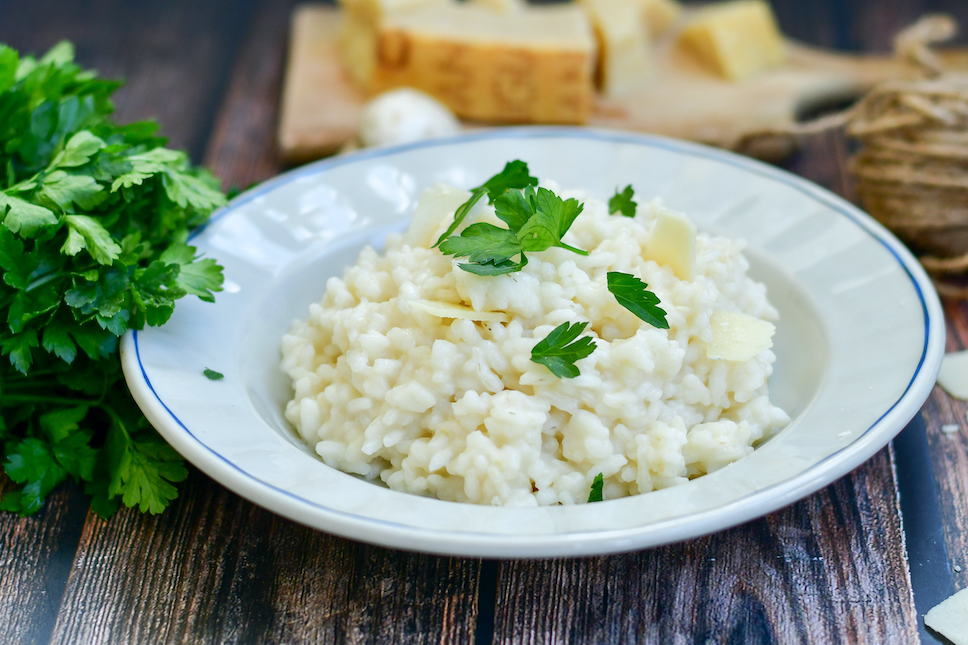
It was late in my 20s that I discovered Risotto & I’ve been smitten since. The beauty & difficulty of Risotto is in its simplicity. You have to get the basics right or you can end up with a rather uninspiring dish.
A couple of years ago, I had the fantastic opportunity to attend a master class with expert risotto chef Massimo Rossetto. He revealed his own secrets about this traditional Italian dish or as he calls it ‘the ambassador of Italian cuisine’. Risotto is also about patience, says Chef Massimo: “Risotto is not the kind of dish that you can make while checking your social media.”
Someone recently asked me if Risotto is pasta. The answer, of course, is no. Risotto is made using arborio, carnaroli of vialone nano rice. Certain supermarkets will simply call it “risotto rice”. These types of rice are short-grained and have a high starch content, so it becomes sticky when cooked. Sushi rice is also a type of short-grain rice.

Risotto hails from the Northern part of Italy & is the authentic Italian way of preparing these specific kinds of rice to manipulate the starches & in doing so you will end up with al dente whole rice kernels that are also incredibly creamy.
The sky is the limit with the kind of flavours that can be added to Risotto, but I would recommend that you start with Risotto Bianco if you’re a first-timer. You can also try my Pea & Bacon Risotto or my Mushroom Risotto.
Cook’s Tips:

When it comes to risotto, the basics are crucial, so here are some tips from me & Chef Massimo:
- Start with good homemade stock like a flavorful vegetable stock. The quality of your stock directly impacts the final taste of your risotto. If you are in a serious pinch & you want to use store-bought stock, be sure to buy the best quality that you can find. Just keep in mind that store-bought stock contains salt & other flavouring (which your homemade stock won’t), so be sure to keep that in mind when you season your dish.
- Next up, rice matters! The two main types used in risotto are Arborio and Carnaroli. Arborio rice gives you that creamy texture we all love, while Carnaroli offers a slightly firmer bite. Personally, I love using the Arborio rice from Riso Gallo.
- Don’t be shy with the butter & genuine Parmesan cheese. I’m talking about real butter and Grana Padano or Parmigiano Reggiano here. It’s the butter & parmesan that helps the creaming (mantecatura) of your risotto for that velvety richness that makes a risotto truly authentic.
- Not too much stirring. You may have noticed that American or British chefs stir risotto vigorously to ‘massage out the starch’, however, Italian chefs will tell you that the stirring should be kept to a minimum. Instead, you want to use the wave motion which is basically when the saucepan is swirled backward & forwards until a creamy sauce is formed.
- How to check for doneness: crush one grain of rice on the surface of the kitchen counter. You should only see one white speck inside the rice grain. If you see more than one speck, the risotto should cook more until el dente.
Classic Risotto Bianco Recipe, Serves 4-6:
Ingredients:
½ Onion
2 Garlic cloves, minced
1 ½ Cups Arborio Rice
1 Liter Vegetable stock (homemade if possible)
1/2 Cup dry white (or red) wine
2 Tablespoons unsalted butter
1/2 Cup freshly grated Parmesan cheese
Salt and pepper to taste
Instructions:
- In a saucepan, heat the stock & keep it simmering on low heat throughout the cooking process.
- In a separate large, heavy-bottomed pan, melt one tablespoon of butter over medium heat. Sweat the onion & garlic in the butter.
- Add the rice and stir to coat the grains with butter. This will ‘toast’ the rice.
- Pour in the wine & cook until it is mostly absorbed by the rice.
- Add the hot stock, one ladleful at a time, stirring only enough to mix everything through. Allow the rice to absorb the liquid before adding more. Don’t be tempted to rush this process. Continue until the rice is creamy & cooked to your desired texture (around 16-18 minutes).
- Check for doneness. See cook’s tips above.
- Remove the pan from the heat & add the remaining tablespoon of butter & grated Parmesan cheese.
- Taste. Season with salt & pepper to taste.
- Let the risotto rest for a minute or two before serving, as it will continue to thicken slightly.

Remember, making a perfect risotto is all about patience & using quality ingredients. So, roll up your sleeves, get that pot ready & let’s make some risotto.
Buon appetito!
Yolandi ♥
Images: Shutterstock
